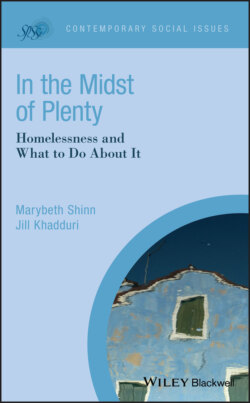Читать книгу In the Midst of Plenty - Marybeth Shinn - Страница 2
ОглавлениеTable of Contents
1 Cover
2 Foreword
3 Acknowledgments
4 Introduction
5 1 Who Becomes Homeless? Where People Sleep: Definitions of Homelessness Data Sources Groups of People Who Experience Literal Homelessness Age, Race, and Gender Changes Over Time Total Numbers Over a Day, a Year, or a Lifetime The Importance of Time Frames Challenges Faced by People Experiencing Homelessness Summary
6 2 What Causes Homelessness? Homelessness, Poverty, and Inequality in an International Context Increasing “Deep Poverty” in the United States Poverty, Housing, and Homelessness Cultural Attitudes, Social Welfare Policy, and Social Exclusion Racism, Social Exclusion, and Homelessness Mental Illnesses and Other Disabilities Sexual Orientation and Gender Identity Other Individual Risk Factors for Homelessness Summary
7 3 Ending Homelessness for People Who Experience It Long‐Term Rental Subsidies for Families Subsidies Plus Voluntary Services for High Needs Individuals Summary
8 4 Comprehensive Efforts to End Homelessness The Homeless Services System Making the System Work to End Homelessness Summary
9 5 Preventing Homelessness for People at Risk Evaluating Prevention for People at High Risk: Efficiency and Effectiveness Programs with Solid Evidence of Effectiveness Programs with Suggestive Evidence of Effectiveness Programs That Might Be Effective Prevention Programs and Cost Benefit Analyses Summary
10 6 Changing Societal Conditions that Generate Homelessness Housing Incomes Countering Social Exclusion Tradeoffs and Combinations for Making Housing Affordable Summary Finding the Political Will to End Homelessness
11 References
12 Index
13 End User License Agreement
List of Illustrations
1 Chapter 1Figure 1.1 Percentage of U.S. Population Using Shelter Over the Course of a ...
2 Chapter 2Figure 2.1 Homelessness is Especially Common in More Expensive Rental Market...Figure 2.2 Hourly Wage that a Full‐time Worker must Earn (Working 40 Hours a...
3 Chapter 3Figure 3.1 Housing First Bypasses the Steps in the Staircase Model of Care a...
4 Chapter 5Figure 5.1 Percentage of Families Entering Shelter by Risk Level and Eligibi...Figure 5.2 Intuitive But Incorrect Model of How Prevention Could Work. In th...
Guide
1 Cover
2 Table of Contents
3 Begin Reading
Pages
1 i
2 iv
3 v
4 vi
5 vii
6 xi
7 xii
8 xiii
9 xv
10 xvi
11 1
12 2
13 3
14 5
15 6
16 7
17 8
18 9
19 10
20 11
21 12
22 13
23 14
24 15
25 16
26 17
27 18
28 19
29 20
30 21
31 22
32 23
33 24
34 25
35 26
36 27
37 28
38 29
39 30
40 31
41 33
42 34
43 35
44 36
45 37
46 38
47 39
48 40
49 41
50 42
51 43
52 44
53 45
54 46
55 47
56 48
57 49
58 50
59 51
60 52
61 53
62 54
63 55
64 56
65 57
66 58
67 59
68 60
69 61
70 62
71 63
72 64
73 65
74 66
75 67
76 68
77 69
78 70
79 71
80 72
81 73
82 74
83 75
84 76
85 77
86 78
87 79
88 80
89 81
90 82
91 83
92 84
93 85
94 86
95 87
96 88
97 89
98 90
99 91
100 92
101 93
102 94
103 95
104 96
105 97
106 98
107 99
108 100
109 101
110 102
111 103
112 104
113 105
114 106
115 107
116 108
117 109
118 110
119 111
120 112
121 113
122 114
123 115
124 116
125 117
126 118
127 119
128 121
129 122
130 123
131 124
132 125
133 126
134 127
135 128
136 129
137 130
138 131
139 132
140 133
141 134
142 135
143 136
144 137
145 138
146 139
147 140
148 141
149 142
150 143
151 144
152 145
153 146
154 147
155 148
156 149
157 150
158 151
159 152
160 153
161 154
162 155
163 156
164 157
165 158
166 159
167 160
168 161
169 162
170 163
171 164
172 165
173 166
174 167
175 168
176 169
177 170
178 171
179 172
180 173
181 174
182 175
183 176
184 177
185 179
186 180
187 181
188 182
189 183
190 184
191 185
192 186
193 187
194 188
195 189
196 190
197 191
198 192
199 193
200 194
201 195
202 196
203 197
204 198
205 199
206 200
207 201
208 202
209 203
210 204
211 205
212 206
213 207
214 208
215 209
216 210
217 211
218 213
219 214
220 215
221 216
222 217
223 218
224 219
225 220
226 221
227 222
228 223
229 224
230 225
231 226
232 227
233 228
234 229
